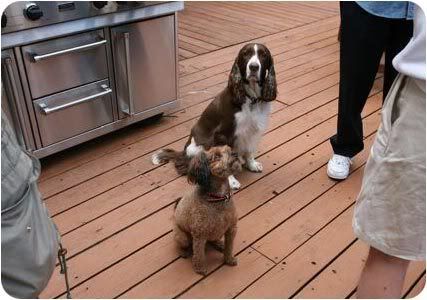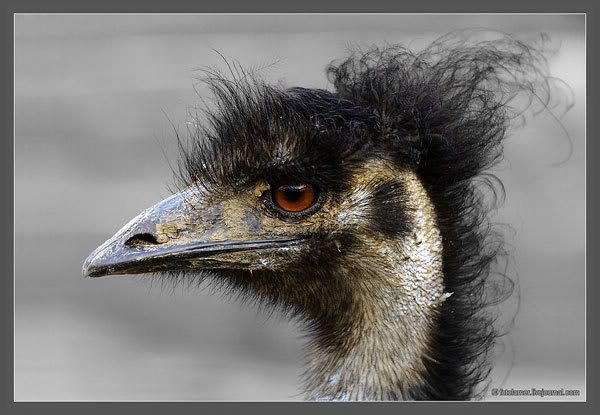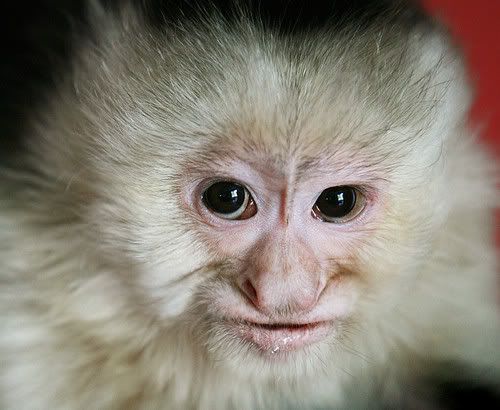Remember dissecting frogs in the glory days of high school biology class? This is a more appealing, and more easily repeated way to learn. Highly detailed anatomic puzzle includes 31 parts with stand and illustrated guidebook. A fascinating learning tool and challenge for kids age 8 and older.
$45.00 at The Afternoon
Sunday, June 29, 2008
3-D Frog Anatomic Model Puzzle
Dog Mugs
 Ceramic mugs with the dog's head as the handle.
114 dog breed designs to choose from.
At Creative Imports. (Looks like you need a membership to even see the prices.)
(via: The J-Walk Blog)
Ceramic mugs with the dog's head as the handle.
114 dog breed designs to choose from.
At Creative Imports. (Looks like you need a membership to even see the prices.)
(via: The J-Walk Blog)
Saturday, June 28, 2008
Video: Dancing On Mother Earth
Clips from the documentary, Dancing on Mother Earth featuring Joanne Shenandoah-contemporary Native American recording artist. Watch video
Friday, June 27, 2008
New bird family tree reveals some odd ducks
The largest study ever of bird genetics has uncovered some surprising facts about the avian evolutionary tree. For the study, conducted by Chicago's Field Museum of Natural History, scientists studied the genetic sequences of 169 bird species in an effort to sort out family relationships in the bird family tree. Scientists believe birds, which first appeared roughly 150 million years ago, evolved from small feathered carnivorous dinosaurs. But their findings challenge many assumptions about bird family relationships and suggest many biology textbooks and bird-watchers' field guides may need to be changed. Falcons, for example, are not closely related to hawks and eagles, despite many similarities, while colorful hummingbirds, which flit around in the day, evolved from a drab-looking nocturnal bird called a nightjar. And parrots and songbirds are closer cousins than once thought. Source: Yahoo News
Thursday, June 26, 2008
Wednesday, June 25, 2008
My cup runneth over
 Awwwww .... it's Baby Ferrets in a Cup!, originally uploaded by Dosh Dosh.
Awwwww .... it's Baby Ferrets in a Cup!, originally uploaded by Dosh Dosh.
Hope on wheels
 Hope, the two-legged Maltese puppy, gets around by using a specially-designed device which features wheels from a model airplane.
Hope was born with only two legs and has small wriggling nubs where her front legs should be. The energetic pup uses her hind legs to boost her body forward onto her chest and operate the wheeled prosthetic limbs.
The wheeled device was created by orthotist David Turnbill free of charge with makeshift shoulder joints connected to model airplane wheels.
Hope, the two-legged Maltese puppy, gets around by using a specially-designed device which features wheels from a model airplane.
Hope was born with only two legs and has small wriggling nubs where her front legs should be. The energetic pup uses her hind legs to boost her body forward onto her chest and operate the wheeled prosthetic limbs.
The wheeled device was created by orthotist David Turnbill free of charge with makeshift shoulder joints connected to model airplane wheels.
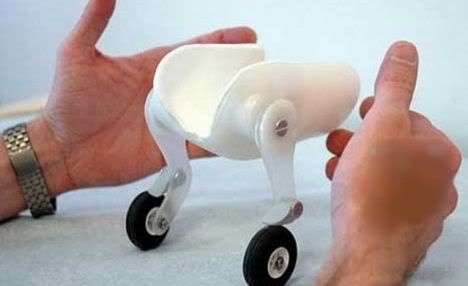 (via Cute Overload)
Source: Daily Mail
(via Cute Overload)
Source: Daily Mail
Tuesday, June 24, 2008
What's the big deal?
As an avid traveler, I've seen dogs in cafes and restaurants in many locations around the world. Just about anywhere but Chicago, it's totally acceptable to bring your dog out with you for breakfast, lunch, or dinner. In Paris, I've seen dogs indoors, sitting right at the table, eating off a plate!
In Chicago, as of January 1, 2008, state law allows for dogs in restaurants, provided that the restaurant obtains license approval, registration, and posts a notice that dogs are allowed. But according to a recent article in Crain's Chicago Business, "Taking Names: Gibsons, RL don't jump to allow dogs," some local eateries seem to be dragging their feet.
The city says there's no wait time — presuming a restaurant has no debt and there are no administrative issues — to receive the $450 dog-friendly license, so why isn't every Chicago restaurant with an outdoor eating area licensed already? Our nice weather season is so short!
 Starbucks in San Diego, CA.
Starbucks in San Diego, CA.
 Restaurant sidewalk cafe in Nürnberg, Germany.
Restaurant sidewalk cafe in Nürnberg, Germany.
 Outdoor restaurant, Szentendre, Hungary.
Outdoor restaurant, Szentendre, Hungary.
 Starbucks outside of the Long Wharf Marriot, in Boston, MA.
Starbucks outside of the Long Wharf Marriot, in Boston, MA.
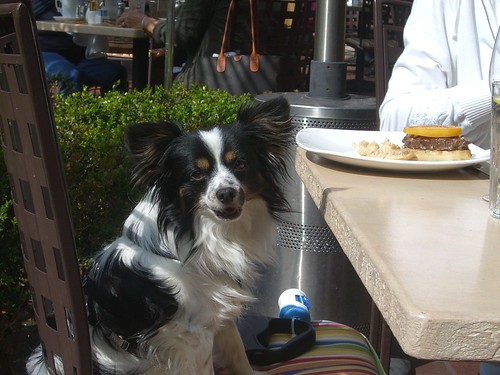 The Prado restaurant in Balboa Park, San Diego, CA.
The Prado restaurant in Balboa Park, San Diego, CA.
Monday, June 23, 2008
 A bald, three-legged, one-eyed dog has been named the 'World's Ugliest Dog' at the 20th annual contest held at the Sonoma-Marin Fair in Petaluma.
The pedigree Chinese crested won the World's Ugliest Dog contest on Saturday at the Sonoma-Marin Fair in Northern California. His owner, Jeanenne Teed, brought Gus all the way from St. Petersburg, Fla., to compete for the dubious distinction.
Gus takes home two trophies and $1,600 in prize money.
A bald, three-legged, one-eyed dog has been named the 'World's Ugliest Dog' at the 20th annual contest held at the Sonoma-Marin Fair in Petaluma.
The pedigree Chinese crested won the World's Ugliest Dog contest on Saturday at the Sonoma-Marin Fair in Northern California. His owner, Jeanenne Teed, brought Gus all the way from St. Petersburg, Fla., to compete for the dubious distinction.
Gus takes home two trophies and $1,600 in prize money.
Cute or not? Komodo dragon hatchling
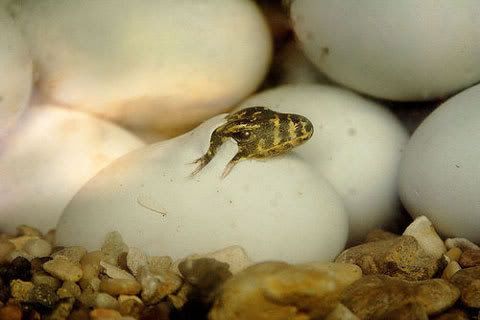 There are currently, at last count fewer than 4,000 Komodo dragons living in the wild, found living on three islands in Indonesia: Komodo, Flores and Rinca.
Scientists report of two cases where female Komodo dragons have produced offspring without male contact.
Photo: Frank Peters
There are currently, at last count fewer than 4,000 Komodo dragons living in the wild, found living on three islands in Indonesia: Komodo, Flores and Rinca.
Scientists report of two cases where female Komodo dragons have produced offspring without male contact.
Photo: Frank Peters
Sunday, June 22, 2008
Vomiting slime-dog toy
In honor of the 30th anniversary of slime, Bandai subsidiary Mega House has announced the August arrival of the “Biri Biri Kaze Hiki Wanko,” which roughly translates to “shocking sick puppy.”
 As reported by Scout Japan, this children’s game functions somewhat like Milton Bradley’s Operation, though with a much higher ick factor: the toy puppy, who has caught a cold, drools a concoction of slime and plastic germs. Players must extract these germs using the tweezers without letting the metal part touch the slime, an act which produces a buzzing shock. The player who collects the most germs wins.
(via Boing Boing)
As reported by Scout Japan, this children’s game functions somewhat like Milton Bradley’s Operation, though with a much higher ick factor: the toy puppy, who has caught a cold, drools a concoction of slime and plastic germs. Players must extract these germs using the tweezers without letting the metal part touch the slime, an act which produces a buzzing shock. The player who collects the most germs wins.
(via Boing Boing)
Hands-free dog walking
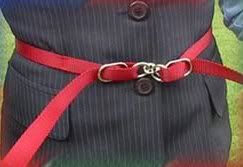 Walk one or two dogs hands free! Always have custody and control of your dog! Secure it around you waist as tight or as loose as you like. It can also be held as a regular leash!
The Waist Walker was developed by a professional pet sitter and designed to walk one or two dogs without the worry of them getting away from you.
This is a quality 15' double ended lead with center clips. Great for walking or jogging in open areas. Perfect for those with limited mobility with your hands, arms or shoulders.
$19.95 at Waist Walker
Walk one or two dogs hands free! Always have custody and control of your dog! Secure it around you waist as tight or as loose as you like. It can also be held as a regular leash!
The Waist Walker was developed by a professional pet sitter and designed to walk one or two dogs without the worry of them getting away from you.
This is a quality 15' double ended lead with center clips. Great for walking or jogging in open areas. Perfect for those with limited mobility with your hands, arms or shoulders.
$19.95 at Waist Walker
Saturday, June 21, 2008
Friday, June 20, 2008
Alligator found in Chicago River
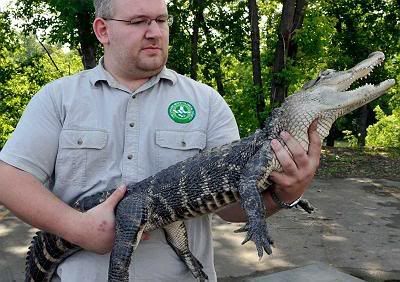 An alligator was found in the Chicago River on the South Side Friday afternoon, police said.
The alligator, which is about 5 1/2 to 6 feet long, was found near 37th Street and the Chicago River about 2:15 p.m. by a citizen who called police.
The city’s department of Animal Care & Control, 2741 S. Western Ave., took the alligator, which was alive, and no injuries were reported.
Source: Chicago SunTimes
An alligator was found in the Chicago River on the South Side Friday afternoon, police said.
The alligator, which is about 5 1/2 to 6 feet long, was found near 37th Street and the Chicago River about 2:15 p.m. by a citizen who called police.
The city’s department of Animal Care & Control, 2741 S. Western Ave., took the alligator, which was alive, and no injuries were reported.
Source: Chicago SunTimes
Air travel is really starting to stink
MIAMI (AP) — An uninvited passenger created a smelly situation on a plane in Miami. American Airlines Flight 915 from Miami to Bogota, Colombia, was delayed Wednesday night after a skunk was found in the back of the cargo hold. When crews tried to remove the skunk, the animal released its notorious rotten smell. No one was injured, but the odor filtered through the cabin and passengers were taken off the plane. The skunk was removed from the plane, but it was unclear where it was taken or how it got on the aircraft.
How's this for cuteness?
There can't be too many things cuter than a red panda baby.
 The Knoxville Zoo has a pair of brand new residents. Zoo officials confirm two baby red pandas were born earlier in the week.
The mother is Kumari and the father is Chewbacca. The cubs are on exhibit with their mother, but the zoo staff is keeping a close eye on them.
Since 1977, when Knoxville's first pair of red pandas, Bernice and Buster arrived, the zoo has had 93 births, more than any other North American zoo.
The Knoxville Zoo is also home to the oldest red panda in captivity, Flo, age 18.
There is also a set of twin baby red pandas at the Edmonton Valley Zoo. Tai and Pip, who were born May 26 to Lala, made their first public appearance on Thursday.
The Knoxville Zoo has a pair of brand new residents. Zoo officials confirm two baby red pandas were born earlier in the week.
The mother is Kumari and the father is Chewbacca. The cubs are on exhibit with their mother, but the zoo staff is keeping a close eye on them.
Since 1977, when Knoxville's first pair of red pandas, Bernice and Buster arrived, the zoo has had 93 births, more than any other North American zoo.
The Knoxville Zoo is also home to the oldest red panda in captivity, Flo, age 18.
There is also a set of twin baby red pandas at the Edmonton Valley Zoo. Tai and Pip, who were born May 26 to Lala, made their first public appearance on Thursday.

 The twins were removed shortly after birth when the mother began aggressively holding and grooming one of the babies endangering its life. To ensure their survival, the babies will be hand raised by Sandy Heiliker, the Valley Zoo’s Animal Health Technologist.
The twins were removed shortly after birth when the mother began aggressively holding and grooming one of the babies endangering its life. To ensure their survival, the babies will be hand raised by Sandy Heiliker, the Valley Zoo’s Animal Health Technologist.
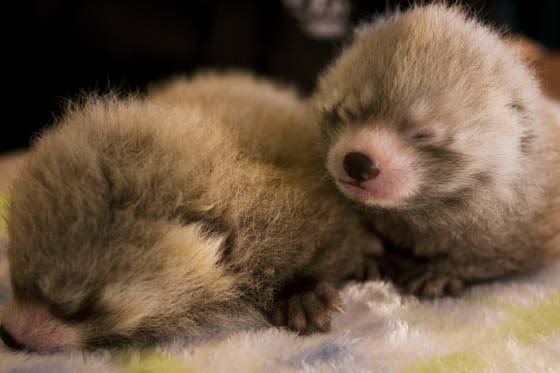
 It's estimated there are around 2,000 to 5,000 red pandas in the wild, although it's not known how the recent earthquake in Chengdu, China, may have affected this count.
It's estimated there are around 2,000 to 5,000 red pandas in the wild, although it's not known how the recent earthquake in Chengdu, China, may have affected this count.
Tiger smugglers in Texas?
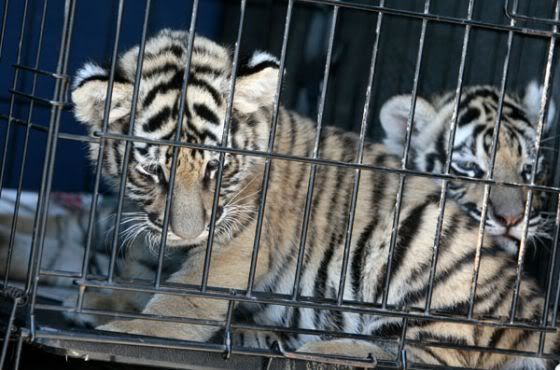 Federal authorities continue to investigate the parking lot sale of six Bengal tigers they believe were bound for Mexico.
49-year-old Michelle Ashton of Calvert, TX, was charged with misdemeanor interference with public duties, after she allegedly became disruptive with police Sunday.
The investigation started when a police officer spotted Ashton exchanging pet cages with people at a store parking lot. The astute patrol officer moved in and noticed that the animals inside were no ordinary kitties.
They were six endangered Bengal tiger cubs.
Investigators believe the cubs were possibly headed to Mexico without proper permits.
The tiger cubs are now at the Gladys Porter Zoo in Brownsville. Zoo officials say the cubs are in excellent condition.
The three male and three female cubs, believed to be two to eight weeks old, are receiving veterinary care at the zoo.
Source: chron.com
Federal authorities continue to investigate the parking lot sale of six Bengal tigers they believe were bound for Mexico.
49-year-old Michelle Ashton of Calvert, TX, was charged with misdemeanor interference with public duties, after she allegedly became disruptive with police Sunday.
The investigation started when a police officer spotted Ashton exchanging pet cages with people at a store parking lot. The astute patrol officer moved in and noticed that the animals inside were no ordinary kitties.
They were six endangered Bengal tiger cubs.
Investigators believe the cubs were possibly headed to Mexico without proper permits.
The tiger cubs are now at the Gladys Porter Zoo in Brownsville. Zoo officials say the cubs are in excellent condition.
The three male and three female cubs, believed to be two to eight weeks old, are receiving veterinary care at the zoo.
Source: chron.com
Eyes over Africa
 In 2006, to fulfill a long-held dream, widely acclaimed photographer Michael Poliza and friend Stefan Breuer undertook a helicopter journey across Africa. Skimming close to the ground, they flew over 19 countries.
In 'Eyes over Africa
In 2006, to fulfill a long-held dream, widely acclaimed photographer Michael Poliza and friend Stefan Breuer undertook a helicopter journey across Africa. Skimming close to the ground, they flew over 19 countries.
In 'Eyes over Africa' Poliza shares the astounding beauty, scale and diversity of this imposing continent.
At the website, Eyes over AFRICA XXL, you can see some of these outstanding images.
Thursday, June 19, 2008
Triplet tiger cubs surprise Auckland Zoo
Three Sumatran tiger cubs have been born at Auckland Zoo. The zoo's big cat keepers are celebrating after discovering the proud mother, eight-year-old Molek, has given birth to triplets nearly a week after the event. They had been keeping their distance since the birth last Thursday, not wanting to disturb Molek for at least a week. On Tuesday, they discovered what they had thought was one cub from afar was actually two. Then, on Wednesday afternoon, they saw a very relaxed Molek lying back with one cub suckling and two others cuddled into her coat. In light of the fact that there are fewer than 400 Sumatran tigers in the wild, and just 160 in captive facilities, the birth of these cubs really is a huge deal, not just for New Zealand, but internationally.
Trouble is $10 million poorer
 In papers that were unsealed June 16, Manhattan surrogate court judge Renee Roth, along with New York State’s Attorney General’s Office, reduced Leona Helmsley's dog Trouble’s trust fund from $12 million to $2 million.
The deal also entailed $6 million in payments to Helmsley’s two disinherited grandchildren, amid their allegations that Helmsley wasn’t mentally competent when she signed her will.
Trouble now will have to get by for the rest of her life on a measly $2 million.
Helmsley's will had asked that either her brother or grandson David Panzirer care for the dog, neither of them was interested, so Trouble is living in Florida with Carl Lekic, the general manager of the Helmsley Sandcastle Hotel.
Lekic says Trouble's annual expenses are around $190,000, which includes his $60,000 guardian fee, $100,000 for 'round-the-clock security, $8,000 for grooming, $3,000 for miscellaneous expenses, $1,200 for food and anywhere from $2,500 to $18,000 for medical care.
Source: NY Post
In papers that were unsealed June 16, Manhattan surrogate court judge Renee Roth, along with New York State’s Attorney General’s Office, reduced Leona Helmsley's dog Trouble’s trust fund from $12 million to $2 million.
The deal also entailed $6 million in payments to Helmsley’s two disinherited grandchildren, amid their allegations that Helmsley wasn’t mentally competent when she signed her will.
Trouble now will have to get by for the rest of her life on a measly $2 million.
Helmsley's will had asked that either her brother or grandson David Panzirer care for the dog, neither of them was interested, so Trouble is living in Florida with Carl Lekic, the general manager of the Helmsley Sandcastle Hotel.
Lekic says Trouble's annual expenses are around $190,000, which includes his $60,000 guardian fee, $100,000 for 'round-the-clock security, $8,000 for grooming, $3,000 for miscellaneous expenses, $1,200 for food and anywhere from $2,500 to $18,000 for medical care.
Source: NY Post
Killer virus threatens fish in in Great Lakes
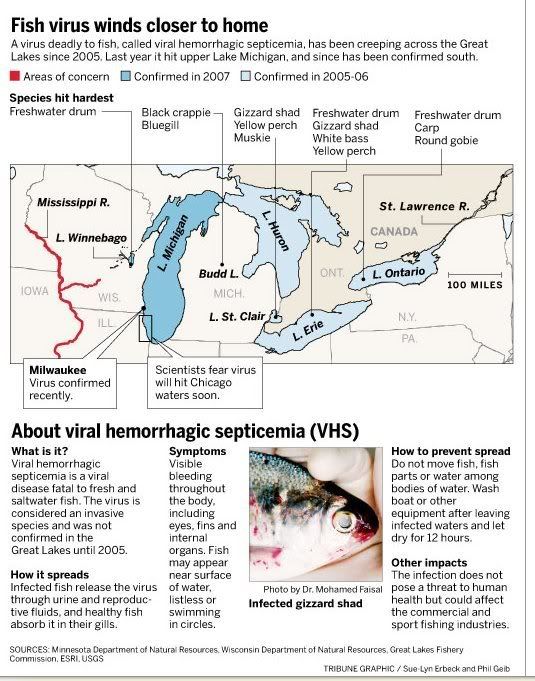 (Click photo for full-size)
When thousands of bloody, hemorrhaging fish recently turned up on the Lake Michigan shore south of Milwaukee, it confirmed the worst fears of scientists worried that an Ebola-like virus stalking Great Lakes fish would strike closer to Chicago.
Unlike many other diseases that tend to hit one or two types of fish, this viral strain has led to large fish kills involving more than 30 species, including valuable sport fish such as salmon, trout, walleye, muskie, bass and perch.
The infection, called viral hemorrhagic septicemia or VHS, doesn't threaten human health but could be devastating to the $4 billion commercial and sport fishing industry in the Great Lakes.
Viral hemorrhagic septicemia is an invasive species. The virus tends to be more destructive and pervasive here than in the lakes and rivers of Europe where it originated, but it's difficult to predict how it will affect Great Lakes species in the long term.
Some fish can resist the virus, but they can still spread it through urine and other fluids. Those that get sick become listless and ultimately bleed to death.
(Click photo for full-size)
When thousands of bloody, hemorrhaging fish recently turned up on the Lake Michigan shore south of Milwaukee, it confirmed the worst fears of scientists worried that an Ebola-like virus stalking Great Lakes fish would strike closer to Chicago.
Unlike many other diseases that tend to hit one or two types of fish, this viral strain has led to large fish kills involving more than 30 species, including valuable sport fish such as salmon, trout, walleye, muskie, bass and perch.
The infection, called viral hemorrhagic septicemia or VHS, doesn't threaten human health but could be devastating to the $4 billion commercial and sport fishing industry in the Great Lakes.
Viral hemorrhagic septicemia is an invasive species. The virus tends to be more destructive and pervasive here than in the lakes and rivers of Europe where it originated, but it's difficult to predict how it will affect Great Lakes species in the long term.
Some fish can resist the virus, but they can still spread it through urine and other fluids. Those that get sick become listless and ultimately bleed to death.
Wednesday, June 18, 2008
The duck gets washed
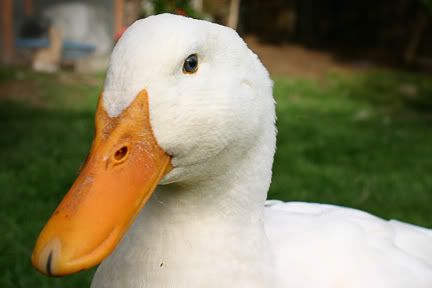 Chewy has had his Stuffy since he was just a little baby duckling. They are best of friends and Chewy drags Stuffy all over the yard to share in the fun.
See what happens when Stuffy gets cleaned up.
Chewy has had his Stuffy since he was just a little baby duckling. They are best of friends and Chewy drags Stuffy all over the yard to share in the fun.
See what happens when Stuffy gets cleaned up.

The story of Nebbeline
I chanced across an excellent photoset at Flickr, The story of Nebbeline (Ms. Freaky Beaky), which is the story of a duck with a very unusual beak.
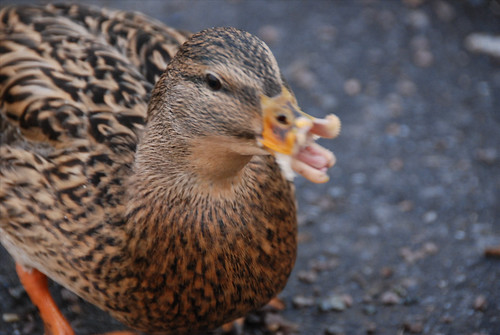 The photographer, Cynthia, aka tuxette, lives in Oslo, Norway.
She met Nebbeline (nebb is the Norwegian word for beak) on a very cold, snowy Sunday in January while feeding the other ducks and taking photos.
The photographer, Cynthia, aka tuxette, lives in Oslo, Norway.
She met Nebbeline (nebb is the Norwegian word for beak) on a very cold, snowy Sunday in January while feeding the other ducks and taking photos.
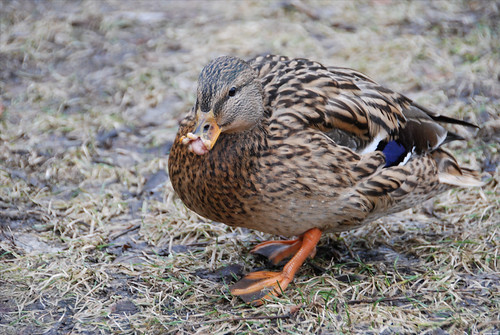 Nebbeline's beak is very short and curved up, and her lovely pink tongue sticks out. She looks like she was born with a birth defect. The duck version of cleft palette, maybe?
Here's a closeup of that beak:
Nebbeline's beak is very short and curved up, and her lovely pink tongue sticks out. She looks like she was born with a birth defect. The duck version of cleft palette, maybe?
Here's a closeup of that beak:
 While she was slightly smaller than the other ducks, Nebbeline did not look unfed. Still, Cynthia felt concerned and has brought special treats to feed the duck, such as crickets from a local pet shop.
While she was slightly smaller than the other ducks, Nebbeline did not look unfed. Still, Cynthia felt concerned and has brought special treats to feed the duck, such as crickets from a local pet shop.
 It looks like Nebbeline enjoys finger food. According to Cynthia, she even enjoys the fingers!
It looks like Nebbeline enjoys finger food. According to Cynthia, she even enjoys the fingers!
Tuesday, June 17, 2008
Would you?
 Some women in New York are paying big bucks for a facial containing bird excrement.
The Geisha Facial, available at Shizuka New York for $180, contains nightingale excrement.
The Japanese powder, also known as uguisu no fun, is rich in the amino acid guanine, said to brighten and cleanse skin. In the 18th century geishas and kabuki actors used the powder to clean heavy white makeup off their faces.
"I was a little tentative at first," said Andrea Nieto, who recently received the treatment. "But there was no smell. It was creamy and rich."
Yeah, right.
Source: Reuters
Photo: Futamer
Some women in New York are paying big bucks for a facial containing bird excrement.
The Geisha Facial, available at Shizuka New York for $180, contains nightingale excrement.
The Japanese powder, also known as uguisu no fun, is rich in the amino acid guanine, said to brighten and cleanse skin. In the 18th century geishas and kabuki actors used the powder to clean heavy white makeup off their faces.
"I was a little tentative at first," said Andrea Nieto, who recently received the treatment. "But there was no smell. It was creamy and rich."
Yeah, right.
Source: Reuters
Photo: Futamer
The Craziest Pet Gadgets
Petside.com has compiled a list of crazy, weird and out-of-control pet products you've got to see to believe. Hmmm, I'll have to look through my old posts to see what I can come up in the "crazy gadgets" category.
Science of cats - where did they come from?
Feline experts say cats have surpassed the dog and become the most popular pet on earth. But how did the cat evolve from a wild animal to a pampered pet? In the upcoming National Geographic Channel documentary Explorer: Science of Cats, (Watch June 17) anthropologists and feline geneticists trace the evolution of the cat. Dr. Leslie Lyons leads a research team studying the genetics of the domestic cat at the University of California, Davis School of Veterinary Medicine. In the interview excerpted here, she explores the origins and domestication of the house cat. The interview with Lyons shares some fascinating facts. For example, while humans deliberately domesticated dogs, cats adapted themselves to us rather than the other way around. We used dogs and made them work for us, but cats cats tolerated humans because we provided food.
Animal management by morons
 The animal shelter in the town of Helena-West Helena, Arkansas, was so run down a regional humane society worker cut the locks last winter and released all the dogs.
The city then moved the operation to a temporary fenced-in area outdoors at the city sanitation department.
Still, people complained that the animals were not properly cared for at the temporary quarters, so the mayor decided the dogs would be better off fending for themselves in the St. Francis National Forest.
Mayor James Valley authorized the city street director to release about 10 dogs into the forest after the animals were fed and watered.
"They are better off free," the mayor said Thursday in a telephone interview.
The mayor said if animal control officers get a call now, "they're going to pick the dog up and probably just take them to the other side of town. And it's going to be someone else's problem. ... or maybe they will take them to the forest."
Source: The Daily World
Mayor Valley's email: mayorjfvalley@gmail.com
The animal shelter in the town of Helena-West Helena, Arkansas, was so run down a regional humane society worker cut the locks last winter and released all the dogs.
The city then moved the operation to a temporary fenced-in area outdoors at the city sanitation department.
Still, people complained that the animals were not properly cared for at the temporary quarters, so the mayor decided the dogs would be better off fending for themselves in the St. Francis National Forest.
Mayor James Valley authorized the city street director to release about 10 dogs into the forest after the animals were fed and watered.
"They are better off free," the mayor said Thursday in a telephone interview.
The mayor said if animal control officers get a call now, "they're going to pick the dog up and probably just take them to the other side of town. And it's going to be someone else's problem. ... or maybe they will take them to the forest."
Source: The Daily World
Mayor Valley's email: mayorjfvalley@gmail.com
Monday, June 16, 2008
Clever monkey
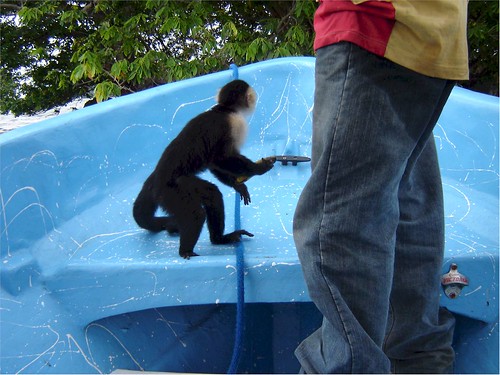 One of two spider monkeys recently added to the Washington Park Zoo broke out of its enclosure this week while workers were cleaning the moat, which had been emptied of water. The spider monkey used a garden hose to scale the wall of the moat.
Zoo Director Johnny Martinez says workers had figured the monkeys would remain inside their enclosure during the cleaning despite the lack of water in the moat to act as a barricade.
Once past the moat, the escaped monkey jumped onto the roof of a water filtration plant and then visited a local boat dealership. The monkey was sitting on top of a white and blue speedboat when captured.
Source: AP
Photo: toonersteve
One of two spider monkeys recently added to the Washington Park Zoo broke out of its enclosure this week while workers were cleaning the moat, which had been emptied of water. The spider monkey used a garden hose to scale the wall of the moat.
Zoo Director Johnny Martinez says workers had figured the monkeys would remain inside their enclosure during the cleaning despite the lack of water in the moat to act as a barricade.
Once past the moat, the escaped monkey jumped onto the roof of a water filtration plant and then visited a local boat dealership. The monkey was sitting on top of a white and blue speedboat when captured.
Source: AP
Photo: toonersteve
Canine flu documented in Illinois
Is Rover coughing? It could be dog flu. Experts urge pet owners to be on the alert now that the disease has been confirmed in Illinois. Canine influenza or "dog flu," is an infectious but treatable disease that was first identified in racing greyhounds in Florida in 2004 and has spread to more than 20 states. Most dogs recover just fine from this influenza, just like most people do from the human version. Canine flu, whose symptoms include a hacking cough, lethargy and vomiting phlegm, can be mistaken for kennel cough. Both conditions affect dogs confined to close quarters, like animal shelters, grooming facilities and day-care centers for dogs. As a species, dogs have not been exposed to the virus long enough to develop immunity. Most dogs who are exposed will get infected and 80 percent will get sick. Dogs are contagious for 7 to 10 days after infection, whether or not they show symptoms, which can drag on for three weeks. There is no approved vaccine to prevent canine influenza. Active cases are typically treated with antibiotics meant to ward off secondary infections such as bacterial pneumonia, which can be fatal to puppies, ailing dogs and older dogs. Experts also recommend that pet owners keep coughing dogs away from other dogs. Source: Chicago Tribune
Sunday, June 15, 2008
Cow Tape Measure
 his adorable cow uses her tail for more than swatting flies. Pull out her tail when you need to measure something.
$6.95 at the Spoon Sisters
his adorable cow uses her tail for more than swatting flies. Pull out her tail when you need to measure something.
$6.95 at the Spoon Sisters
Cow Cookie Jar
This playful cow heifer offers up her cookies with a wink, knowing you can’t resist. That little wink means this cow will keep your secret when you sneak an extra cookie, creates a soothing, subtly country setting with casual appeal. This cow cookie jar is a perfect way to accesorize your kitchen countertop. Great for cookies, crackers or other snacks, it's a must have for the old country style kitchen lover.
$20.40 at Discount Home Decor
Saturday, June 14, 2008
Friday, June 13, 2008
Pregnant for Father's Day
 In the weedy sea dragon family it's the dads that carry the eggs, and this one is pregnant for only the third time ever at a U.S. aquarium, Georgia Aquarium officials said.
The sea dragon has about 70 fertilized eggs — which look like small red grapes — attached to his tail. He is expected to give birth in early to mid-July.
Sea dragons, sea horses and pipe fish are the only species where the male carries the eggs.
Source: Newsvine
In the weedy sea dragon family it's the dads that carry the eggs, and this one is pregnant for only the third time ever at a U.S. aquarium, Georgia Aquarium officials said.
The sea dragon has about 70 fertilized eggs — which look like small red grapes — attached to his tail. He is expected to give birth in early to mid-July.
Sea dragons, sea horses and pipe fish are the only species where the male carries the eggs.
Source: Newsvine
The California Condor
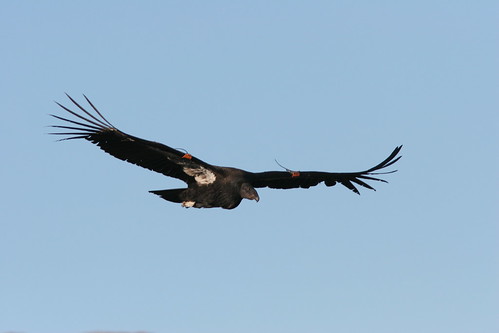 The California condor (Gymnogyps californianus) is the largest land bird in North America with a wingspan of 9 1/2 feet and weighing up to 22 pounds.
Today, the California condor is regarded as one of the rarest birds in the world. In prehistoric times, condors ranged from Canada to Mexico, across the southern United States to Florida, and north on the east coast to New York.
Between the mid-1880s and 1924, there were scattered reports of condors in Arizona. But by the late 1930s, all remaining condors were found only in California and by 1982, the total population had dwindled to just 22 birds and extinction loomed.
The California condor was placed on the federal endangered species list in 1967. The U.S. Fish and Wildlife Service began a captive breeding program in 1980, but in the wild, condor numbers continued to decline until only nine birds remained in 1985.
The California condor (Gymnogyps californianus) is the largest land bird in North America with a wingspan of 9 1/2 feet and weighing up to 22 pounds.
Today, the California condor is regarded as one of the rarest birds in the world. In prehistoric times, condors ranged from Canada to Mexico, across the southern United States to Florida, and north on the east coast to New York.
Between the mid-1880s and 1924, there were scattered reports of condors in Arizona. But by the late 1930s, all remaining condors were found only in California and by 1982, the total population had dwindled to just 22 birds and extinction loomed.
The California condor was placed on the federal endangered species list in 1967. The U.S. Fish and Wildlife Service began a captive breeding program in 1980, but in the wild, condor numbers continued to decline until only nine birds remained in 1985.
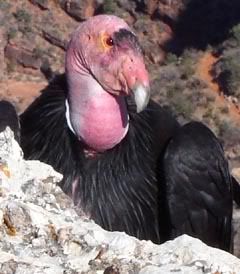 A controversial decision was made to bring all remaining condors into captivity and the last wild bird was captured on April 19, 1987. All hope for recovery was now placed on the captive breeding program and the task was formidable.
Captive bred condors were being released back into the wild in California beginning in January 1992. Today, condors fly free in California and Arizona/Utah.
June 2008 California Condor Update
The U.S. Fish & Wildlife service has recently come out with a California condor status report as of April 30, with the following numbers (likely higher by now since eggs hatch in May)
World Total: 315
CA: 78 plus 6 chicks=84
Baja: 13
Arizona/Utah: 64 not counting chicks (of which we suspect 3 as of May 10, and TWO other possible eggs still to hatch!)
A controversial decision was made to bring all remaining condors into captivity and the last wild bird was captured on April 19, 1987. All hope for recovery was now placed on the captive breeding program and the task was formidable.
Captive bred condors were being released back into the wild in California beginning in January 1992. Today, condors fly free in California and Arizona/Utah.
June 2008 California Condor Update
The U.S. Fish & Wildlife service has recently come out with a California condor status report as of April 30, with the following numbers (likely higher by now since eggs hatch in May)
World Total: 315
CA: 78 plus 6 chicks=84
Baja: 13
Arizona/Utah: 64 not counting chicks (of which we suspect 3 as of May 10, and TWO other possible eggs still to hatch!)
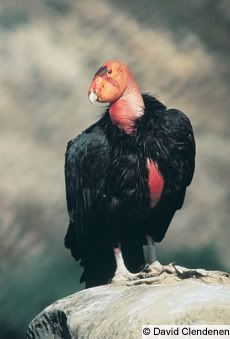 Some very unusual California Condor traits
Condors do not have vocal cords so they force air through their body to make hissing and grunting noises.
Condors defecate on their legs to reduce their core body temperature. This is known as Urohydrosis.
Condors can soar and glide at up to 50 miles per hour and travel 100 miles or more per day.
Condors eat an average of 2-3 lbs at a feeding.
Adult condors show their emotion through skin color changes.
Condors become sexually mature at about five or six years of age and mate for life.
Condors lay a single egg normally every other year. The egg, about 5 inches in length and weighing around 10 ounces is deposited on bare ground. Condors do not build nests.
Chicks are born with their eyes open.
When scared, condors regurgitate (throw up) their stomach contents.
Condors do not have talons like eagles or hawks; their nails are more like toenails.
Some very unusual California Condor traits
Condors do not have vocal cords so they force air through their body to make hissing and grunting noises.
Condors defecate on their legs to reduce their core body temperature. This is known as Urohydrosis.
Condors can soar and glide at up to 50 miles per hour and travel 100 miles or more per day.
Condors eat an average of 2-3 lbs at a feeding.
Adult condors show their emotion through skin color changes.
Condors become sexually mature at about five or six years of age and mate for life.
Condors lay a single egg normally every other year. The egg, about 5 inches in length and weighing around 10 ounces is deposited on bare ground. Condors do not build nests.
Chicks are born with their eyes open.
When scared, condors regurgitate (throw up) their stomach contents.
Condors do not have talons like eagles or hawks; their nails are more like toenails.
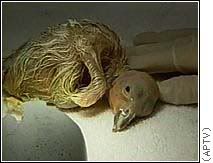 The photo at left is of a condor chick hatched March, 2008. This chick is the 60th baby bird hatched at the San Diego Wild Animal Park since the Condor Recovery Program was implemented in 1982. The chick's mother was the first California condor to be conceived and hatched in captivity. (CNN story)
Refrences: nps.gov, ventana, All About Birds
Photo #1: ehoyer
Photo #2: Grand Canyon National Park
Photo #3: David Clendenen
Photo #4: CNN
The photo at left is of a condor chick hatched March, 2008. This chick is the 60th baby bird hatched at the San Diego Wild Animal Park since the Condor Recovery Program was implemented in 1982. The chick's mother was the first California condor to be conceived and hatched in captivity. (CNN story)
Refrences: nps.gov, ventana, All About Birds
Photo #1: ehoyer
Photo #2: Grand Canyon National Park
Photo #3: David Clendenen
Photo #4: CNN
First English beaver dam in 800 years
 The medieval clergyman and chronicler Giraldus Cambrensis made the last recording of beavers in Britain in 1188. He said they were only found in one river in Wales and one in Scotland. They were hunted to extinction by the 13th century.
In 2007, staff at the Escot Estate in Ottery St Mary, Devon, created a two-acre home for a pair of European beavers with ponds and woodland along a section of the River Tale.
John-Michael Kennaway of the Escot Esate thinks the beavers might have built their dam, the first in England in 800 years, because they may be breeding.
Over recent years, 15 beavers have been re-introduced to England, but these have lived on lakes and had no need to build a dam.
Source: Mail Online
The medieval clergyman and chronicler Giraldus Cambrensis made the last recording of beavers in Britain in 1188. He said they were only found in one river in Wales and one in Scotland. They were hunted to extinction by the 13th century.
In 2007, staff at the Escot Estate in Ottery St Mary, Devon, created a two-acre home for a pair of European beavers with ponds and woodland along a section of the River Tale.
John-Michael Kennaway of the Escot Esate thinks the beavers might have built their dam, the first in England in 800 years, because they may be breeding.
Over recent years, 15 beavers have been re-introduced to England, but these have lived on lakes and had no need to build a dam.
Source: Mail Online
Thursday, June 12, 2008
Dogs with balls
Funny Pets blog has posted a collection of dogs with balls. There's nothing more fun!
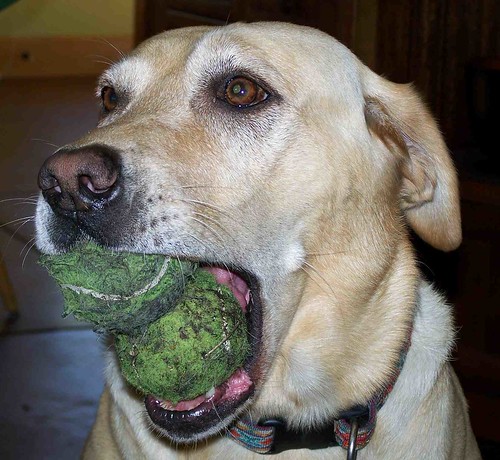 "Mouthfull" uploaded by siskiyoulaura.
"Mouthfull" uploaded by siskiyoulaura. found here
found here
